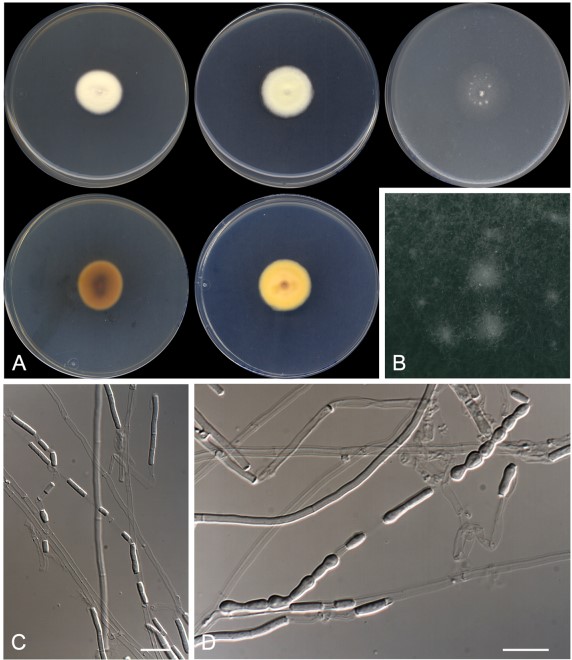Pseudomalbranchea gemmata Rodr.-Andr., Cano & Stchigel, sp. nov.(Fig. 10)
MycoBank number: MB 835221; Index Fungorum number: IF 835221; Facesoffungi number: FoF;
Etymology: From the Latin gemmatum, jewelled, be- cause the swollen conidia disposed in chains.
Diagnosis: Pseudomalbranchea gemmata is phylogenetically close to Uncinocarpus reesii and Amauroascus volatilis-patellis. However, it does not produce a sexual morph and it differs from U. reessi and A. volatilispatellis by the production of longer arthroconidia (4.0– 11.0 × 2.0–3.5 μm in P. gemmata vs. 3.5–6.0 × 2.5–3 μm in U. reessi, and 4.0–5.4 × 2.0–3.0 in A. volatilis-patellis; Orr and Kuehn 1972, Sigler and Carmichael 1976, Cur- rah 1985). As well as A. volatilis-patellis, P. gemmata lacks appendages, which are present and similar to the asexual morph in U. reessi (Currah 1985).
Type: USA: Florida: from human bronchial washing specimen, 2014, N. Wiederhold (CBS H-24459 – holo- type, CBS 146933 = FMR 17684 = UTHSCSA DI18-90 –ex-type cultures; LSU/ITS sequences GenBank LR701762/LR701761).
Description: Mycelium sparse, composed of hyaline, smooth- and thin-walled, sparsely septate hyphae, 1.0–2.0 μm wide. Conidia enteroarthric (occasionally holoarthric), intercalary disposed along unbranched vegetative hyphae, one-celled, solitary or in short chains of up to 7, onecelled, hyaline, smooth- and thick-walled, cylindrical but becoming globose with the age, 4.0–11.0 × 2.0–3.5 μm, liberated from the fertile hyphae by rhexolysis (rarely by schizolysis). Chlamydospores, racquet hyphae and sexual morph not observed.
Culture characteristics: Colonies on PYE reaching 22– 23 mm diam after 2 wk. at 25 °C, slightly elevated, velvety, margins regular, pale yellow (3A3), sporulation sparse; reverse brown (6E6). Colonies on PDA reaching 24–25 mm diam after 2 wk. at 25 °C, slightly elevated, velvety, margins regular, pale yellow (3A3), sporulation sparse; reverse light yellow (4A5). Colonies on PDA reaching 25–26 mm diam after 2 wk. at 30 °C, flattened, radially folded, velvety, margins regular, pale yellow (3A3), sporulation sparse; reverse light yellow (4A5). Colonies on OA reaching 28–29 mm diam after 2 wk. at 25 °C, flattened, velvety to granulose, irregular margins, white (6A1), sporulation sparse. Exudate and diffusible pigment lacking. Minimum, optimum and maximum temperature of growth on PDA: 10 °C, 30 °C, and 37 °C, respectively. Colonies haemolytic, casein not hydrolyzed. The fungus was not inhibited by cycloheximide. Urease and esterase tests positive. Growth occurs at NaCl 3% w/w, but not higher concentration.

Fig. 10 Pseudomalbranchea gemmata CBS 146933 T. a Colonies on PYE, PDA and OA after 14 d at 25 °C, from left to right (top row, surface; bottom row, reverse). b Detail of the colony on OA. c–d Large, intercalary, irregularly-shaped arthroconidia disposed singly or in chains along the fertile hyphae. Scale bar = 10 μm
